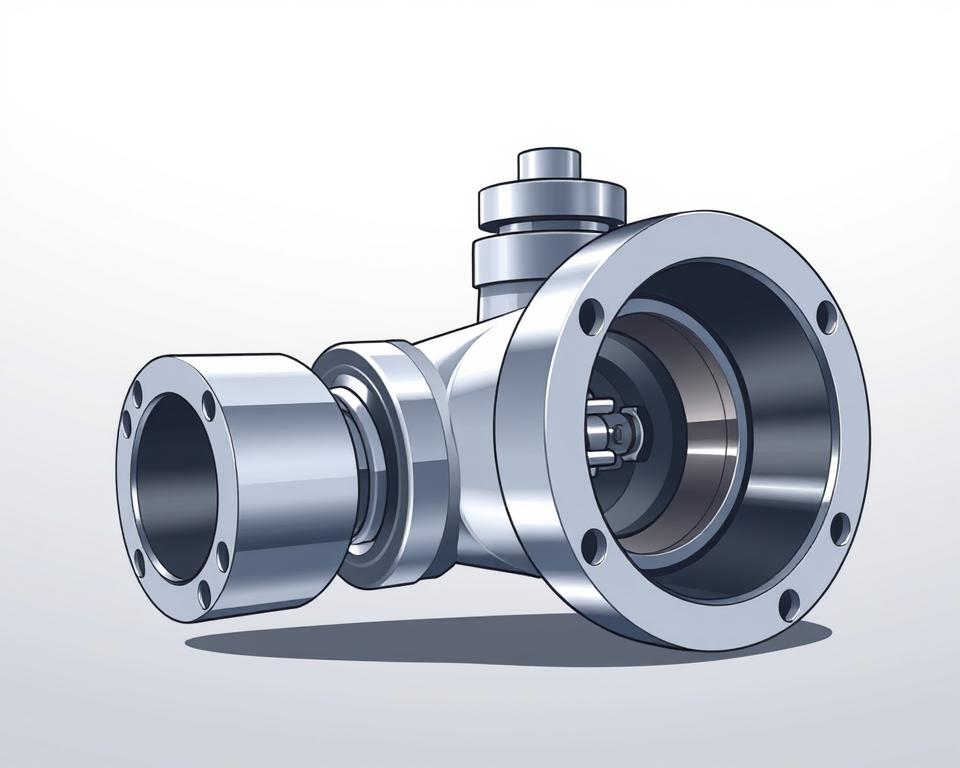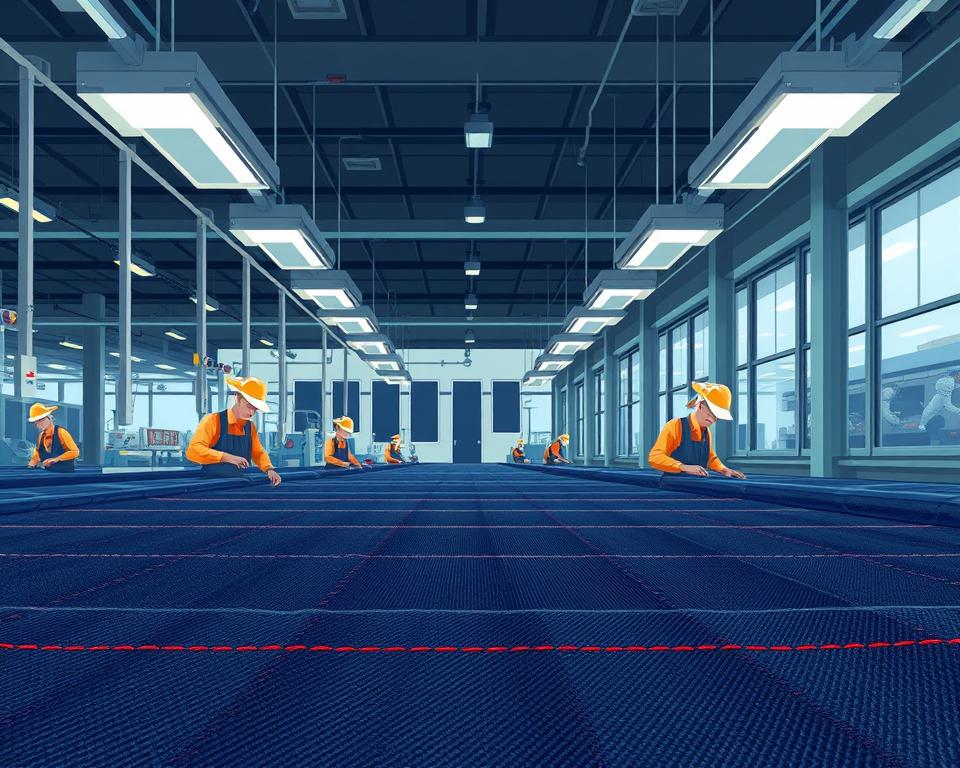Premier Self-edge Jean Textile Producers Handbook
Did you know that self-edge denim, renowned for its robustness and timeless appeal, is made by talented craftsmen? The process of self-edge denim commences with the material makers who carefully weave and create this notable denim fabric. Locating the ideal self-edge denim material producers is essential to guaranteeing the highest quality and craftsmanship in your jeans.
If you’re on the hunt for the top selvedge denim, look no further. In this detailed manual, we’ll lead you through the best selvedge denim fabric manufacturers, disclosing the labels that are renowned for their commitment to superiority and exactness. From Ironheart and Samurai to Pure Blue Japan and Oldblue, we’ll examine the top brands that embody the essence of selvedge denim fabric.
But first, let’s unravel the basics of self-edge denim and understand why it has entranced denim fans and fashion aficionados alike. Learn about the craftsmanship, legacy, and distinctive qualities that make Japanese-made, American, and European-made self-edge denim truly exceptional. From the fabrication technique to the various weights and attributes, we’ll explain the self-edge spectrum and equip you with the knowledge to make a smart decision.
So, whether you’re a denim connoisseur or just beginning your foray into the universe of self-edge denim, this guide will be your trusted companion in discovering the top selvedge denim fabric manufacturers and uncovering the spirit of this timeless fabric. Let’s begin this jean adventure together and find out the best that self-edge denim has to provide.
Selvedge Denim Essentials: Learning the Essentials
Selvedge denim is a pillar of quality craftsmanship and timeless style. But what exactly is self-edge denim, and what makes it unique from its peers? In this part, we will explore the basics of self-edge denim, shedding light on its distinctive features and why it has attracted such a dedicated audience.
Selvedge denim is a type of denim textile woven on traditional shuttle looms, which produce a closed edge on both sides of the textile. This finished edge, marked by the iconic colored lines lining the outside of the seam, inhibits fraying and unraveling, leading to a neater, longer-lasting textile. This careful attention to detail in the weaving process makes self-edge denim in high demand by denim enthusiasts.
One of the unique traits of self-edge denim is its connection to top-tier quality and denser fabric. Manufacturers, particularly those in Japanese, are known for their proficiency of selvage denim creation, employing long-threaded cotton fibers and traditional methods to craft denim that is not just long-lasting but also possesses a textured richness and character depth.
Grasping selvage denim fundamentals is crucial to recognizing the singularity of this fabric. The next segment will explore the legendary Japanese textile mills responsible for producing some of the finest self-edge denim in the globe.
Legacy and Artistry: Japanese Selvedge Demystified
This part delves into the deep legacy and impeccable craftsmanship behind Japanese selvedge denim. Japanese has traditionally been associated with outstanding denim creation, and its weaving factories have achieved fame in the market. Let’s explore some of these famous weaving factories and uncover the special characteristics that make Japanese-made denim truly exceptional.
Famous Japanese Weaving Factories
Japanese self-edge denim attributes its renown for superior craftsmanship to the expertise and commitment of its mills. Some of the most respected names in the field include:
| Textile Mill | Place |
|---|---|
| Amhot Weaving Factory | Okayama Region |
| Kuroki Weaving Factory | Yamagata |
| Japan Blue/Collect Weaving Factory | Kojima City |
| Kaihara Mills | Hiroshima |
| Nihon Menpu Textile Mill | Tokyo Region |
| Toyoshima Mills | Chiba Prefecture |
These textile mills have established themselves as trailblazers in making some of the finest self-edge denim in the market. Each factory brings its distinctive style and artistry to the denim creation process, leading to a wide array of choices for jean lovers.
Special Characteristics of Japanese Selvage
Japanese selvage is esteemed for its superior quality and distinctive characteristics. Here are some of the main traits that make Japanese-made denim unique:
- Premium Quality: Japanese textile mills highly value using the best materials and utilizing traditional techniques to create denim with unmatched toughness and comfort.
- Heavier Weight Fabric: Japanese denim is often crafted using thicker textiles, known for their robustness and potential to generate beautiful fades with age.
- Reputation for Excellence: Japanese-made denim is generally considered as the epitome of top-tier denim textile, sought after by denim connoisseurs around the globe.
These distinctive traits render Japanese selvedge denim a preferred option among denim enthusiasts and curators who value the craftsmanship and craftsmanship that is involved in making each pair of jeans.
Learning about American Selvage: Famed Factories and Their Stories
When it comes to American selvage, there are a few iconic mills that have had a huge influence on the industry. One of the most well-known is Cone Textile Mill, which is distinguished as being the last selvedge denim mill in the USA.
Cone Textile Mill has a rich history, going back to the late 19th century, and its association with Levi’s Jeans has been crucial in the acceptance of American denim. The superior material made by Cone Mills has been used in Levi’s denim for generations, making it synonymous with the legacy of American denim.
Aside from Cone Textile Mill, there are other notable American ewingfly denims mills that have contributed to the market expansion and reputation. The White Oak Division, a section of Cone Textile Mill, was renowned for its premium denim before its closure in 2017. Another famed factory is Rogue Territory Mills, which has gained recognition for its craftsmanship and devotion to producing top-tier denim.
Opting for top-tier selvage from these American textile mills provides many benefits. The durability of the material secures that your jeans will endure long-term use and numerous washes. Additionally, the unique fading patterns that form with age produce a individualized and one-of-a-kind style, making each denim pair truly one-of-a-kind. With US-made selvage, you get great bang for your buck.
| Mills | Year Founded | Key Achievements |
|---|---|---|
| Cone Textile Mill | the year 1891 | Provider of material for Levi’s |
| White Oak Division (Cone Mills) | the early 20th century | Known for premium denim before closure in 2017 |
| Rogue Territory | the early 21st century | Recognized for craftsmanship and high-quality denim |
Uncovering European Expertise in Denim Production
European selvedge denim is renowned for its outstanding skill and excellence. In this part, we highlight two Italian masters of denim production: Candiani Weaving Factory and Berto Weaving Factory. These weaving factories have established a solid reputation in the field for their superior denim fabric.
The Italian Masters: Candiani and Berto Mills
Candiani Weaving Factory, located in Italy, has been creating some of the finest denim textile since the mid-20th century. With a strong commitment to environmental responsibility, Candiani Weaving Factory uses advanced techniques and eco-friendly practices to create superior denim that meets the top standards.
- Their textiles are renowned for their smoothness, strength, and beautiful color changes.
- The European self-edge denim from Candiani is preferred by trendsetting labels and discerning denim enthusiasts alike.
- They provide a variety of denim options, from lightweight to thick, allowing for versatility in various apparel designs.
Berto Mills, another esteemed Italian weaving factory, has been at the forefront of denim production for a century and two decades. With a deep legacy and commitment to age-old skill, Berto Mills keeps to deliver exceptional denim fabric that matches the top requirements.
- Berto’s European selvage is famous for its special characteristics, with textured thickness and gorgeous wear patterns.
- Berto Textile Mill offers a variety of jean thicknesses and surface treatments, enabling fashion experts and denim fans to produce unique and personalized pieces.
- They focus on eco-friendly production methods and use organic and recycled materials to reduce the planetary burden of denim production.
Achievements of Cone Textile Mill: America’s Jean History
While uncovering European expertise, it’s important to acknowledge the contributions of Cone Mills, an iconic American denim mill, to European textile heritage. Cone Textile Mill has been a pioneer in the jean market for over a century, renowned for its devotion to excellence and innovation.
- Cone Mills’ selvedge denim fabrics have been employed by renowned denim brands around the globe, showcasing the versatility and durability of American denim.
- Their European selvedge denim options encompass a diverse selection of styles, thicknesses, and coatings, meeting the different requirements of denim experts and denim enthusiasts.
- From traditional blue denim to new elastic versions, Cone Textile Mill keeps to push the boundaries of denim manufacturing.
European selvage denim lovers are are overwhelmed with choices with the top-tier options from Candiani Textile Mill, Berto Mills, and the legacy of Cone Mills. These weaving factories symbolize the peak of craftsmanship and exemplify the devotion to superiority that has made European self-edge textiles greatly desired in the clothing field.
The Selvage Material Makers
In the realm of selvage, a diverse selection of makers contribute to the creation of this superior material. Each producer brings its distinctive craftsmanship, resulting in a wide array of selvage names. Discovering different manufacturers is essential in discovering the ideal pair of selvedge jeans that match personal tastes.
Below is a complete compilation of selvedge denim fabric manufacturers known for their exceptional quality and craftsmanship:
| Producer |
|---|
| Ironheart |
| Samurai Jeans |
| Oni Denim |
| Pure Blue Japan |
| The Flat Head |
| Full Count |
| Benzak Denim Developers |
| Indigofera |
| Blaumann |
| Ooe Yofukuten |
| Oldblue |
These makers have made themselves as pioneers in the selvage textile field. Each label has its individual flair, shape, and material makeup, catering to different needs.
Whether you’re a hardcore jean lover or a style-savvy person, it’s vital to learn about the offerings from assorted selvage makers to locate the ideal pair of denim that align with your unique look.
The Skill of Denim Fabrication: Creating Selvage
Denim weaving is a careful artistry that is crucial in the production of self-edge textile. The intricate weaving process includes the crossing of yarns to form the unique crosswise structure that denim is known for.
Traditional Weaving Machines vs. Modern Looms
Two varieties of weaving machines are primarily used in jean knitting: loom shuttles and modern weaving machines. Loom shuttles are vintage, less fast devices that produce self-edge denim. These textile makers include a shuttle that transports the weft thread through the lengthwise fibers. The created material has a finished border, known as the self-edge, which stops unraveling and highlights the skill of the knitting method.
On the other hand, high-speed looms are up-to-date, fast devices that are widely used in large-scale fabrication. These weaving machines propel the weft thread across the vertical yarns using a thin rod or aerodynamic system. While high-speed looms are good at large-scale denim production, they do not create selvedge denim fabric by the yard owing to their inability to create the closed edge.
The Importance of Unwashed Denim in Self-edge Making
Unwashed denim, also referred to as natural or uncleaned denim, plays a crucial role in the fabrication of selvedge fabric. Untreated denim is produced from cotton threads that have not gone through any initial cleaning or treatments, preserving the innate qualities of the fabric.
When untreated denim is knitted on shuttle weaving machines, it produces a sturdy and heavy textile with a more compact interlacing. The nonexistence of initial cleaning permits the denim material to create distinct wear patterns and folds as they age, resulting in a personalized and distinctive look. This is why lovers of unwashed selvage value the superior and long-lasting nature of selvedge jeans.
The combination of shuttle looms and untreated denim demonstrates the artisanal craftsmanship and attention to detail that is used in making selvedge fabric. Each pair of selvedge jeans conveys a narrative through its knitted build and raw texture, making them a preferred option among denim connoisseurs.
Understanding the Self-edge Range: Classes and Traits
In the world of self-edge denim, weights and qualities play a significant role in the distinctiveness of the material. Self-edge textiles are available in a variety of weights, and each weight has its own characteristics and benefits.
A common factor to take into account when learning about self-edge denim is the thickness of the material. Self-edge textile types can range, and denser classes are often associated with durability and long-lasting wear. These textiles have a closer interlacing and are less prone to wear and tear, making them ideal for those looking for a strong and long-lasting denim pair.
Alongside thicknesses, selvage materials also has a range of attributes that enhance its attraction. One of these qualities is roughness, which indicates the uneven weight or thinness of the yarns found in the fabric. Slubby selvedge denim has a bumpy and irregular surface, adding an touch of individuality and eye-catching look.
Surface is another key trait of selvage materials. Based on the knitting method employed and the type of yarns, self-edge textiles can have a coarse or soft surface. The feel of the textile impacts the overall look and touch of the denim, creating a distinct tactile experience.
Wear pattern formation is another feature to think about when discovering self-edge textiles. Some kinds of selvage materials are known for their exceptional fading properties, permitting the textile to show wear and create distinct designs over time. This characteristic enhances the individuality of selvedge denim and the narrative it conveys through its appearance.
Overall, the selvedge spectrum includes a wide range of densities and features, permitting individuals to select the fabric that fits their preferences and ideal comfort. Whether looking for durability, texture, or wear patterns, selvedge denim offers a diverse selection of choices to explore.
Crucial Aspects to Evaluate in Selvage Denim
When it comes to choosing the perfect pair of self-edge jeans, evaluating crucial aspects can be essential. Two vital elements to take into account are textile density and strength.
Textile Density and Toughness
Material thickness determines the density and strength of the jeans, directly impacting its toughness and longevity. Heavier weight selvedge denim, usually between 14-21 ounces, is typically more durable and resistant to wear and tear, making it an suitable selection for individuals wanting jeans that can resist hard wear and provide extended wear.
The toughness of selvage denim is further enhanced by the tightly woven construction of the material. The use of classic loom shuttles makes a denser weave, leading to a tougher textile that can withstand multiple laundering and daily wear.
For those who prefer a thinner choice, self-edge jeans with a lighter material thickness, ranging from 10 to 13 oz, offers a softer and breathable fit. While thinner jeans may not be as sturdy as thicker choices, it still holds a desirable level of durability and can create one-of-a-kind color changes and character with age.
Wear Pattern Formation and Fabric Traits
One of the hallmarks of selvage denim is its capacity to form individual color changes that reflect the user’s habits and habits. Color changeability refers to the textile’s likelihood to age and produce distinctive patterns and hue changes with repeated wear and washing.
Fabric traits is another important trait to take into account when selecting selvage denim. This indicates the distinctive visual traits, such as roughness, twisted surface, and uneven knitting. These characteristics add to the individuality of the textile and can turn each jean pair original.
Whether you prefer a softer and even wear pattern or a dramatic and pronounced look, grasping the color changeability and textile character of selvage denim can help you select a material that aligns with your individual taste and preferred appearance.
Material Thickness and Strength
| Material Thickness | Toughness |
|---|---|
| Heavyweight (14-21 ounces) | Strong, ideal for hard wear |
| Less dense (10-13 oz) | Tough enough with a more comfortable fit |
Eco-Friendly Practices in Self-edge: Sustainable Creation Techniques
In the universe of self-edge jeans, eco-friendliness has become an growing concern of eco-friendly manufacturing. Shoppers are now more conscious of the environmental impact of the goods they acquire, and the jean market is no outlier. To tackle these challenges, mills like Candiani Textile Mill have risen to be pioneers of eco-friendly self-edge making.
Candiani Textile Mill, recognized as the greenest denim mill in the field, is committed to implementing eco-friendly manufacturing approaches. The weaving factory focuses on lowering water usage, minimizing chemical usage, and employing cutting-edge methods to reach a more sustainable production process. By using these methods, Candiani Textile Mill aims to create jeans that not just aligns with superior benchmarks but also matches the principles of green-minded shoppers.
It is crucial for consumers to make informed choices and support labels and producers that prioritize environmental responsibility. By selecting sustainable selvedge denim, shoppers can contribute to a greener jean market. Together, we can support the adoption of eco-friendly techniques throughout the supply chain and back a eco-friendlier era for jean making.
| Advantages of Eco-friendly Self-edge |
|---|
| 1. Reduced water consumption |
| 2. Reduced chemical use |
| 3. Lower environmental impact |
| 4. Promotes responsible creation |
| 5. Aligns with conscious consumer values |
Denim Innovations: Merging Heritage with Modernity
This section of the article delves into the fascinating realm of denim progress that smoothly merge history with contemporary techniques. Denim, a everlasting and adored textile, has kept changing to match the requirements of current trends while holding fast to its history.
Modern Enhancements in Denim Textiles
With progress in fabric techniques, denim producers have been able to improve the effectiveness and toughness of their textiles. Modern fabrication approaches, such as the use of shuttle looms, produce a denser, denser weave that leads to a stronger and robust material. This not only extends the life of the material but also contributes to superior wear patterns and distinct feel.
Fabric treatments have also played a significant role in enhancing jean fabrics. Specialized treatments, such as enzyme-based rinses and resin applications, can make a range of looks, from distressed and worn-in looks to sleek and polished styles. These treatments provide flexibility to classic jeans, making possible a greater variety of style options and shopper wants.
Advances in Eco-Friendly Practices
In addition to current advancements in denim textiles, the field has made significant breakthroughs in green manufacturing. Recognizing the need to reduce its footprint on the environment, denim manufacturers have been exploring sustainable color applications and adopting the employment of reused components.
By using eco-friendly color applications, such as foam dyeing or organic blue color, producers are cutting down on resources while still producing vibrant and colorfast denim. The use of recycled materials, such as repurposed threads or synthetic threads, helps lessen the requirement for fresh components and redirects fabric scraps from dumps.
This dedication to eco-friendliness guarantees that jean making can continue to thrive without compromising the health of our planet. As the field progresses, incorporating both classic artistry and modern techniques, a more sustainable and ethical method to denim creation will evolve into the new norm.
Current Advancements and Green Manufacturing in Denim
| Modern Enhancements | Eco-Friendly Practices |
|---|---|
| Advanced weaving techniques | Sustainable dyeing processes |
| Textile techniques | Utilization of repurposed substances |
The chart above this text shows the contemporary improvements in denim textiles and the associated innovations in eco-friendliness. It showcases the ongoing efforts of the market to blend tradition and modernity with green techniques, securing a more sustainable and eco-friendlier tomorrow for denim.
Final Thoughts
After exploring the world of selvedge denim fabric manufacturers, it is clear that there is a diverse selection of selections available to jean lovers. From renowned brands like Iron Heart, Samurai Jeans, and Oni Denim to Flat Head Jeans, Full Count, and Indigofera Prima Jeans, each manufacturer adds their individual flair and skill to the table. When it comes to selecting the ideal producer, it is vital to take into account individual preferences and the desired look and feel of the denim material.
In addition to the wide range of makers, the benefits of top-tier unwashed selvage cannot be ignored. Its longevity, better fades, and great bang for your buck render it a valuable purchase for jean enthusiasts. Moreover, sustainability is important in the denim field, and many manufacturers are employing eco-friendly approaches to creation, such as Candiani Mills, known as the greenest denim mill in the industry.
Lastly, the denim industry continues to innovate by blending tradition with technology. Contemporary improvements in denim textiles, such as cutting-edge knitting methods and fabric treatments, boost the effectiveness and durability of selvage denim. Innovations in green manufacturing, such as sustainable color applications and the utilization of repurposed substances, enhance a more sustainable jean market.
In final thoughts, discovering the world of self-edge textile producers gives a diverse selection of options and enables individuals to locate the ideal pair of denim wear that align with their unique preferences. From the advantages of premium raw selvedge denim to green creation and denim progress, there is a lot to explore and appreciate in the universe of selvage denim. So, make the effort to learn about and make informed choices to enjoy the classic look and superiority of self-edge jeans.



